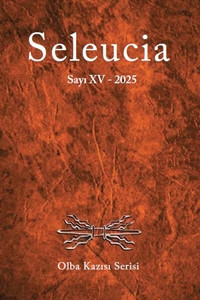Abstract
In this study, an eagle figurine from Burdur Museum will be examined. It was purchased by the museum authorities in 1975 and recorded in the museum inventory. The figurine is made of silver alloy. It was produced with mold technique. In addition, wire, granulation and engraving technique were used. It was defined as a gold medallion eagle figurine due to the gold ornamentation on it.
The eagle figurines are one of the leading artifacts of art of the Roman Empire.They were theologically accepted with various mystical rituals and ideologically became the symbol of political and military power. Their purposes of use changed accordingly and they were used as cult objects, military symbols, grave gifts, furniture and ornaments or accessories belonging to an object. Findings such as melted metal residue and solder marks indicating that the Burdur Museum example was belongs to an object indicate that the figurine is part of an object. The twisted square gold wire wrapping the body of the figurine like an ornament, the serpent soldered to the gold wire on the chest and the ram figure between its claws are the most important defining characteristics that distinguish our work from existing eagle figurines. At the same time, this figurine is a rare example where eagle-serpent-ram figures are defined as a group of works and form a common composition. Another distinguishing feature is that the eagle figurine is made of silver alloy and decorated with gold alloy ornaments. The stylistic and technical features of the figurine provide a historical standard for displaying the craftsmanship of the Hellenistic and Roman Imperial Period. This study initially gives information regarding the defining, technical and iconographic features of the figurine. Secondly, a proposal for its date is presented by an analogical and typological assessment utilizing comparative examples of the figurine.
Keywords
References
- Cass. Dio (= Cassius Dio, Rhomaika) Kullanılan Metin ve Çeviri: Roman History. With an English translation by E. Carry I-IX. London 1914-1927 (The Loeb Classical Library).
- Cic. div. (= Cicero, De divinatione ad M. Brutum) Kullanılan Metin ve Çeviri: De Divinatione ad M. Brutum. With an English translation by W. A. Falconer. London, New York 1964 (The Loeb Classical Library).
Abstract
In this study, an eagle figurine from Burdur Museum will be examined. It was purchased by the museum authorities in 1975 and recorded in the museum inventory. The figurine is made of silver alloy. It was produced with mold technique. In addition, wire, granulation and engraving technique were used. It was defined as a gold medallion eagle figurine due to the gold ornamentation on it.
The eagle figurines are one of the leading artifacts of art of the Roman Empire.They were theologically accepted with various mystical rituals and ideologically became the symbol of political and military power. Their purposes of use changed accordingly and they were used as cult objects, military symbols, grave gifts, furniture and ornaments or accessories belonging to an object. Findings such as melted metal residue and solder marks indicating that the Burdur Museum example was belongs to an object indicate that the figurine is part of an object. The twisted square gold wire wrapping the body of the figurine like an ornament, the serpent soldered to the gold wire on the chest and the ram figure between its claws are the most important defining characteristics that distinguish our work from existing eagle figurines. At the same time, this figurine is a rare example where eagle-serpent-ram figures are defined as a group of works and form a common composition. Another distinguishing feature is that the eagle figurine is made of silver alloy and decorated with gold alloy ornaments. The stylistic and technical features of the figurine provide a historical standard for displaying the craftsmanship of the Hellenistic and Roman Imperial Period.
This study initially gives information regarding the defining, technical and iconographic features of the figurine. Secondly, a proposal for its date is presented by an analogical and typological assessment utilizing comparative examples of the figurine.
Keywords
References
- Cass. Dio (= Cassius Dio, Rhomaika) Kullanılan Metin ve Çeviri: Roman History. With an English translation by E. Carry I-IX. London 1914-1927 (The Loeb Classical Library).
- Cic. div. (= Cicero, De divinatione ad M. Brutum) Kullanılan Metin ve Çeviri: De Divinatione ad M. Brutum. With an English translation by W. A. Falconer. London, New York 1964 (The Loeb Classical Library).
Details
| Primary Language | English |
|---|---|
| Subjects | Archaeological Science |
| Journal Section | Research Articles |
| Authors | |
| Publication Date | May 16, 2025 |
| Submission Date | December 3, 2024 |
| Acceptance Date | April 15, 2025 |
| Published in Issue | Year 2025 Issue: XV |


